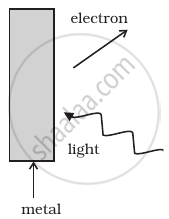Advertisements
Advertisements
प्रश्न
The work function of aluminum is 4⋅2 eV. If two photons each of energy 2⋅5 eV are incident on its surface, will the emission of electrons take place? Justify your answer.
उत्तर
By using Einstein's photoelectric equation is, K. E. = hv - Φ or hv = Φ + K. E. we can say that the emission of electrons takes place only if the incident energy is greater than the work function of the material.
In the given case, total incident energy =2 × 2.5 eV = 5 eV
The work function of aluminum, Φ = 4.2 eV
∵ Incident energy is greater than the work function of the material, hence the emission of electrons will take place.
APPEARS IN
संबंधित प्रश्न
Quarks inside protons and neutrons are thought to carry fractional charges [(+2/3)e; (–1/3)e]. Why do they not show up in Millikan’s oil-drop experiment?
How will the thermionic current vary if the filament current is increased?
Would you prefer a material with a high melting point or a low melting point to be used as a cathode in a diode?
An isolated metal sphere is heated to a high temperature. Will it become positively charged due to thermionic emission?
Why does thermionic emission not take place in non-conductors?
The cathode of a diode valve is replaced by another cathode of double the surface area. Keeping the voltage and temperature conditions the same, will the place current decrease, increase or remain the same?
Define the term "Threshold frequency", in the context of photoelectric emission.
The wave associated with a moving particle of mass 3 × 10–6 g has the same wavelength as an electron moving with a velocity 6 × 106 ms–1. The velocity of the particle is
What do you mean by electron emission? Explain briefly various methods of electron emission.
Consider Figure for photoemission.

How would you reconcile with momentum conservation? Note light (photons) have momentum in a different direction than the emitted electrons.
